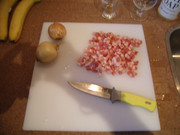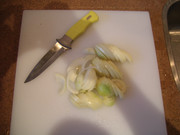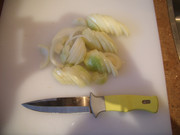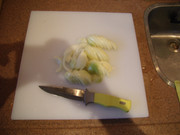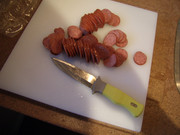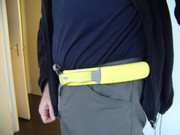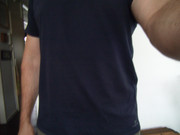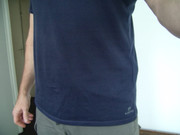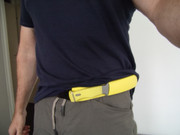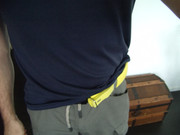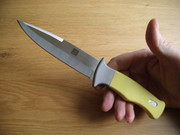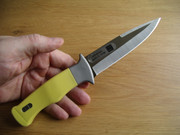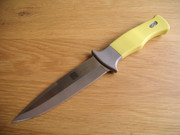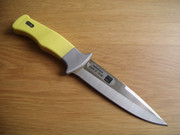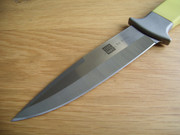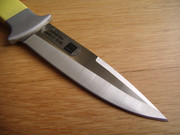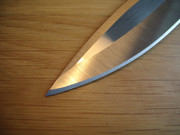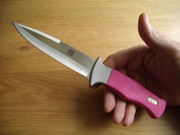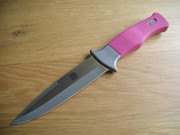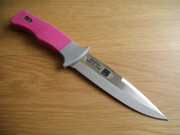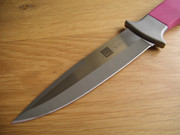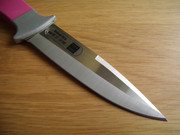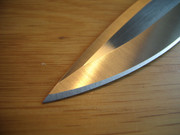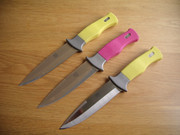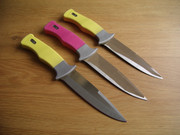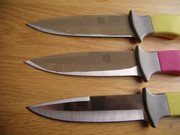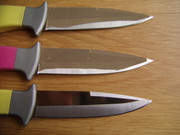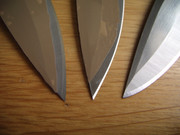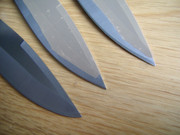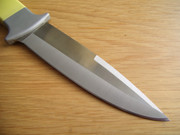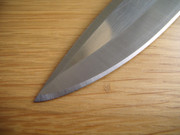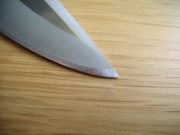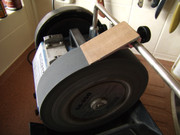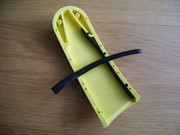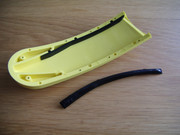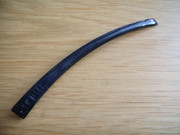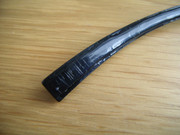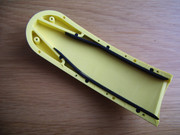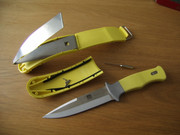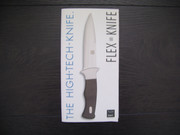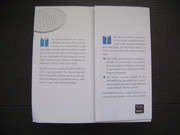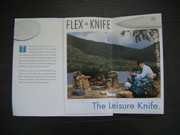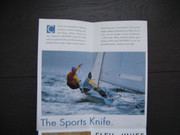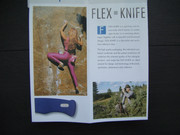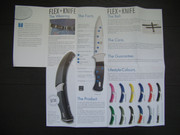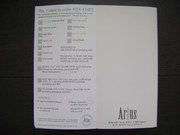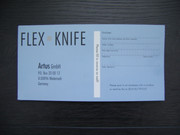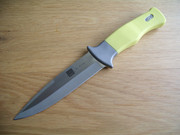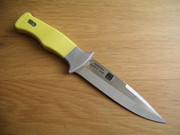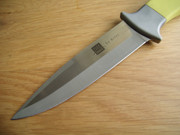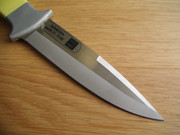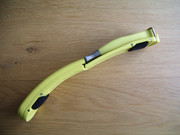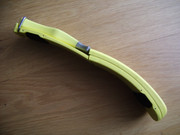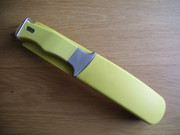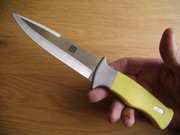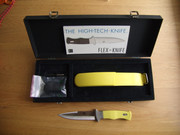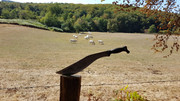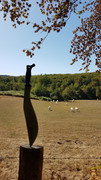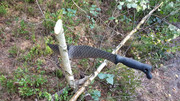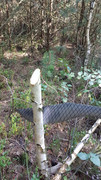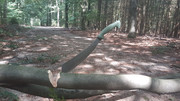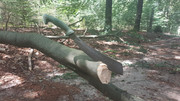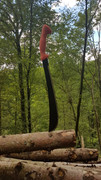Beiträge von kwakster
-
-
This afternoon i carried the first yellow Flex knife on my belt, with the T-shirt tucked in and the fleece jacket covering the sheated knife, which concealed it completely.
Even under just a loose hanging dark blue T-shirt there's not much printing.Impression so far is that the sheated knife wears very comfortably and i don't even notice it when tying my shoelaces, walking around, driving a car, or having a snack at a table.
You could basically carry this knife all day and forget that it's there at all, and yet it's still very accessible.
What also seems to work well (so far anyway) is the PVA glue mod i did inside the sheath, as the self-blunting effect on the edge is gone and it stays sharp. -
This is how the second yellow Flex knife came out:
Blade thickness: 1,0 mm
Thickness behind the edge: 0,30 mm
Edge angle: ~22,5 degrees inclusive
Microbevel: ~30 degrees inclusiveAnd the pink version:
Blade thickness: 0,98 mm
Thickness behind the edge: 0,27 mm
Edge angle: ~22,5 degrees inclusive
Microbevel: ~30 degrees inclusive -
A few days ago i showed the Flex knives to a local pro-Chef who also likes to fish at sea (and serves the catch in his restaurant), and he seemed to like them quite a bit as possible filleting knives, praising their thin flexible blades, presumed saltwaterproof steel, very grippy artificial rubber handles with trustworthy guards, and probably good edge holding as well.
Other possible uses that i can think of atm would be (camp-) kitchen use, and maybe even diving knives. -
Currently busy sharpening two other Flex knives on the Tormek; a second yellow one and a pink one.
From top to bottom: the second yellow knife (with taped blade) which has just been sharpened on the Tormek to ~22,5 degrees inclusive and with the burr still attached to the edge, the pink knife (with taped blade) still with it's ~30 degrees inclusive blunt factory edge, and the first yellow knife. -
The factory edge on this Flex knife measured ~30 degrees inclusive and was reprofiled to ~22,5 degrees inclusive on the Tormek SB-250 Blackstone fitted with the homemade jig you can see in the last picture, then deburred on the Tormek leather wheel coated with 1.0 micron diamond paste.
This provides for just a tiny bit of micro-convexity of the apex which strengthens it, and the resulting edge is now stable & reverse chesthair-whittling sharp.
This was actually the third time i had to redo the sharpening, as the first two times the edge collapsed from a few firm slices into a polyethylene cutting board.
My guess is that the factory edge may have been overheated during sharpening. -
According to the brochure the blade is made from a saltwater proof stainless steel with a hardness between 57-59 HRC, and capable of a highly durable cutting edge.
Now i have exactly zero proof as it isn't mentioned anywhere specifically, but based on this info plus sharpening/deburring/polishing the edge on one of the Flex knives my educated guess would be that the steel might be Becut, as this would fit the properties described almost perfectly.
Wet-grinding completely new bevels on the Tormek SB-250 stone (black silicon carbide) is comparatively slow, and both deburring/polishing with high quality diamond compounds tells me that there are quite a lot of wear-resistant carbides in the steel. -
I think i may have found a solution for the edge blunting from the black glass filled nylon insert.
First step was to grind some material from the insert with only a coarse diamond file, thus also leaving a coarse surface.
After cleaning/degreasing that surface with some isopropyl alcohol on a piece of microfiber cloth i applied 2 layers of waterproof PVA wood glue on the surface of the insert. (allowed each layer to dry overnight)
PVA stands for polyvinyl acetate, which is the same or close to the same material that expensive Hi-Soft cutting boards are made from, and these are known to be very edge friendly on knives.
When everything had thorougly dried I tested the new PVA surface by slicing it several times with a freshly sharpened cheap peeling knife (picture 4), and this did not noticeably seem to blunt it's apex.
Next step will be to resharpen the edge of the Flex knife and see how things go from there. -
The factory edge on this knife was a bit blunt due to one of the black plastic inserts in the sheath, which is made from some form of glass filled nylon.
Not exactly a good choice for a part of the sheath that contacts the edge often.
Will see if i can do something about that.With the sheath partly disassembled showing both black plastic inserts, as well as the one-piece flat stainless spring:
-
-
Recently i obtained several unused Artus Flex knives, and i'm currently experimenting a bit with one of them.
All knives came complete with original box, leaflet, spare belt loops & mini-tool (to exchange them)
The Rockwell hardness sticker is still on the blade.Specs:
Overall length: 24,6 cm
Blade length: 12,7 cm
Blade thickness: 0,96 mm (!)
Handle materials: steel guard & molded rubber grip
Sheath: plastic with spring steel inserts
Weight (knife only): 119,3 grams
Weight (knife + sheath): 260 grams -
Just came home from a camping & hiking holiday in France, mostly in the Morvan nature reserve, which itself lies in the Burgundy region.
Still not very touristic when compared to the south of France, and especially if you like good quality local food, various wines & beers i would highly recommend this region.
The beef cattle you can see in the background of the pictures are of the Blonde D'Aquitaine breed, which thrives in the area and are a prime source of high quality beef.The modified machete again came in very handy during our hikes, as some trails were almost grown shut.
It devours brambles, various types of green undergrowth, as well as both thin & thick saplings with just a flick of the wrist.
Thinner trees with a thickness the size of a grown man's upper arm take just a few hits at speed for them to fall over.
Because of the efficient design of the thin blade together with the high tip speed this machete bites very deep, so consequently on thick wood i do have to wiggle the blade free after each hit, but that is to be expected. -
-
What remains of the second Heavy Duty machete after completely reshaping both the blade & the handle, pictured here below a slightly modified kukri machete.
The idea was to combine an only 2.0 mm thick & lightweight machete blade with a modified kukri form which uses a more forward placed & pronounced belly as it's sweet spot, with an aggressively slicing forward curve as a follow-up.
It's in the testing phase and i'm still working on it, but so far it has already proven to be very effective as well very easy on the wrist joints due to it's low weight.
With a 45 degree angled hit at speed the blade will cleanly pass through a wrist size young birch tree/sapling, almost without feeling the impact.
Thinner springy stuff that isn't immediately severed by a direct hit by the belly gets sliced by the forward curve, but most of the time the combination of a high tip speed with that curvy sweet spot is more than enough to do the job.
The current convex edge is done on 400 grit wet & dry SiC paper on a rubber backing using WD-40 oil as a lubricant, and measures ~30 degrees inclusive.
The handle is contoured & fuzzy finished with the woodrasp.Playing around with crosshatching using a waterproof marker to check on the location & size of the sweet spot as well as the effectiveness of the slicing forward curve after a chopping session.
Currently busy with giving the forward portion of the blade somewhat of a lenticular cross section to further improve upon pass-through cuts.
So far i'm having a lot of fun for only very little money,
Current specs:
Overall length: 51,2 cm
Blade length: 37,5 cm
Blade thickness: 2.0 mm
Weight: 386,9 grams
Steel type: 1055 carbon steel
Hardness: ~56 HRC
Handle material: polypropylene -
Gary Fadden sold Al Mar Knives to Edge Technologies Engineering LLC in January 2019:
-
Italian made A.G.A Campolin Maltese stiletto from a collector.
The knife was recently bought brand new from a foreign shop, but it came with quite a lot of blade play, a very rough ~55 degrees inclusive "edge" with a big burr still attached to it, and no point at all.
Also both sides of the blade aren't mirror images of each other, with a center ridge that is off a bit on one side.
Anyway, especially the lack of a point bothered the owner, the bad edge came in second, and fixing the blade play will probably be a job for another day.
This is how the knife looked before resharpening:
And how the knife looks now.
While keeping the edge angle about the same so the bevels would not widen too much per owner's request, i resharpened the main edge completely and the bayonet grind only superficially to come to a sharp point with a 15 micron diamond compound Paper Wheel, then cleaned up the bevels a bit and removed the tiny burr with a 1.0 micron diamond compound Paper Wheel.
The edge angle again measures ~55 degrees inclusive, yet the new apex is just sharp enough to shave the hair on the back of my hand a bit on skin level.
-
Besides quite a bit of other green growth i used the modified Bushcraft Parang today to cut up a rather large green branch which had fallen from a big beechwood tree, blocking one of the larger woods trails near my home town.
I had already delimbed the branch before i took the pics, but you get the idea.
European beechwood is quite hard & tough, and this main branch had a thickness approaching axe territory, but the parang was what i had in my daypack and it handled the job very well.Used quite a few maximum force chops to see how the now thinner convex edge with an apex of ~ 30 degrees inclusive would hold up, and the blade took it like a champ; no rippling, denting, rolling or any other damage that i could see or feel.
Afterwards the edge could still shave a bit of hair on the back of my hand, this with an 800 grit finish on wet & dry SiC paper using WD40 as a lubricant.
The blade bites deep on each swing, the new handle shape & surface finish function as intended, and the hooked handle end has also proven to be a very useful addition.
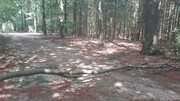
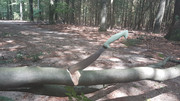
-
A week ago we got home from a camping holiday in the Luxembourg forests and the Belgian Ardennes, and the Condor Eco Golok machete did a wonderful job at trail clearing during several long hikes in the area.
The model is somewhat of a wolf in sheeps clothes, in that it isn't overly big or menacing looking, but it sure is a highly effective chopping tool without being unwieldy.
It's a bit less tip heavy compared to my CS kukri machete, giving it a better balance and thus making it less tiresome in the longer run.
I can swing this machete for hours on end, and without gloves.The Condor Eco Golok machete stuck in a log somewhere in Luxembourg.
The edge is starting to discolour from all the wood sap and other mostly green stuff.The only modification i made to the handle was a bit of smooth sanding where my index finger sits, as only in that spot the fuzzy finish was starting to create a bit of a hot spot while chopping.
On the rest of the handle the fuzzy finish has proven to greatly enhance grip without being abrasive on my hands, probably due to the fact that the protrusions left by the wood rasp aren't rigid.
The fuzzy finished polypropylene surface also is quite durable and doesn't seem to wear smooth (after several weeks of intermittent use) like the same finish on a PVC handle definitely will.After resharpening with just the smooth file and cleaning the handle with an old toothbrush and some diluted detergent:
Strong points for me:
- The Eco Golok machete fits inside my daypack (only just)
- the low weight of only 433 grams (after modding and resharpening)
- the very well hardened 1075 steel.
- Using just two files it takes and holds a good convex edge @ +/- 30 degrees inclusive, even on dried wood it did not fold or dent.
- the negatively angled handle
- the contouring (mod)
- the fuzzy/chewy finish (mod)
- the way this model transfers kinetic energy into the wood without vibrating, which together with the narrow convex edge makes for a deep bite upon impact, thus making it a highly efficiënt chopper in a small package.What i don't like:
The edge contacts some of the steel rivets when sheating & unsheating, which each time creates a bit of edge damage.
I intend to make another sheath without rivets for it. -
Street violence and home invasions have been on the rise for several years now in the Netherlands, with almost all perpetrators being of muslim background.
Stigmatizing ?
Probably, but nonetheless very true.
They are mostly younger men of fighting age, and capable of extreme violence, especially towards the weak and the elderly, but basically towards anyone opposing them even in the slightest of ways.With firearms as a legal means of self defense practically ruled out by our self-appointed elite (all of them having armed guards, riding in chauffeur-driven armored cars, and often living in well-protected gated communities, while most likely also having a secret firearms license for themselves), many ordinary people are looking for other ways to defend their life and loved ones.
A friend of mine lives with his young family in a remote rural area, where a few home invasions have already taken place with people he knows directly.
We almost never read about these in the media, simply because our MSM is in bed with the elite, and have decided amongst themselves to report as little as possible about these "incidents" as they continue to call them.
Especially where muslims as the perpetrators are concerned.Recently i modified this Cold Steel Magnum Kukri to better suit the needs of my friend.
This Cold Steel/Lasher product in it's basic form has a very good price to quality ratio (even in this highly taxed country), it is legal to own & use on your own property (the adding of a sharpened swedge makes it illegal to carry and/or use on public streets or land) and with a little work it becomes even more useful for it's intended purpose, which in this case is to lie next to a bed hopefully never being put into use.
If however push comes to shove it will never malfunction, and nobody will blink an eyelid if the item needs to be turned in or disposed of after use.I put on a new convex edge as well as a convex swedge (apex on both measures +/- 30 degrees inclusive, which is as thin as possible yet thick enough) using only a cheap Chinese 120 grit diamond file, making sure that the microteeth in the edge all point a bit backwards for maximum bite in that direction.
Another reason for such a coarse edge is the fact that when being cut with, it hurts noticeably more compared to being cut with a finer edge, and the resulting wound also takes noticeably longer to heal (personal experience)
Both the main edge and the now sharpened swedge can shave the hair on the back of my hand a bit on skin level, which is most likely enough sharpness for it's intended purpose.
Both edges come together in a piercing point which will penetrate much easier than the factory version, yet the back of the blade leaves enough real estate to put your off-hand on to aid in blocking hits with a stick or bat.The blade length of this particular model especially gives the wielder most likely a distance advantage, which can be very useful if the bad guys use a knife too (many home invaders here do, together with baseball bats): you can reach him, while he can't reach you.
Also gave the handle surface the "fuzzy finish" treatment for maximum grip in the hour of need, even with very sweaty hands.
Lastly i sanded the black coating lightly and then gave the whole blade including both coarse bevels a thorough coating with a good quality car wax (scratches hold the wax better), to help protect the rust prone carbon steel (and it's sharp edges) while it lies unused next to, or under the bed.Another consideration in all this was the information i learned some time ago from a friend, who is an active duty Dutch Special Forces member.
He told me that when doing duty in muslim countries, and this may sound strange, is that the locals in general seem to have noticeably more respect for edged weapons then for firearms, especially when up close.
Never had this piece of intel verified by others, but i also have no reason to doubt him.
If true, and there would be even the slightest chance that brandishing this item could help to avoid a violent confrontation altogether due to it's perceived deterring effects, so much the better.Specifications of this specific example:
Overall length: 22.24 inches (56,5 cm)
Blade length: 16.9 inches (43,0 cm)
Blade thickness: 2,93 mm (which is quite rigid, certainly not flimsy of wobbly)
Steel type: 1055 carbon steel (not stainless, but extremely tough)
Handle material: moulded on PVC (dampens shock effectively)
Weight without sheath: 546 grams
Weight with sheath: 674 grams -
Incolma history video in the Spanish language, but with English subtitles:

